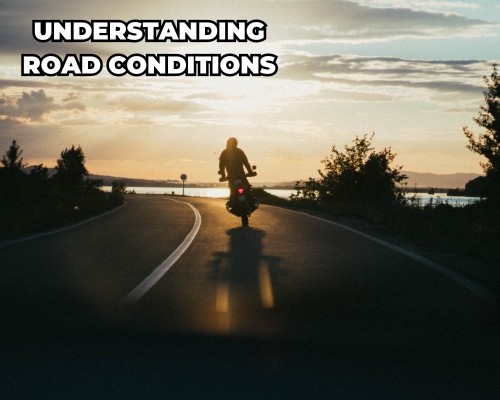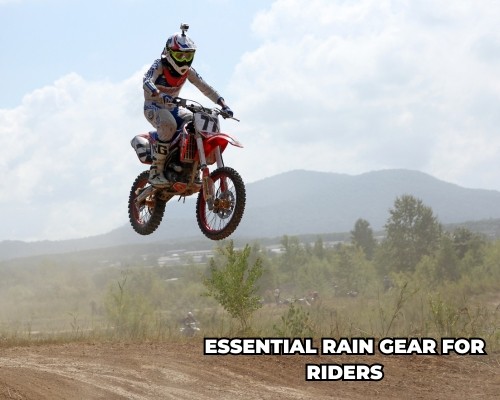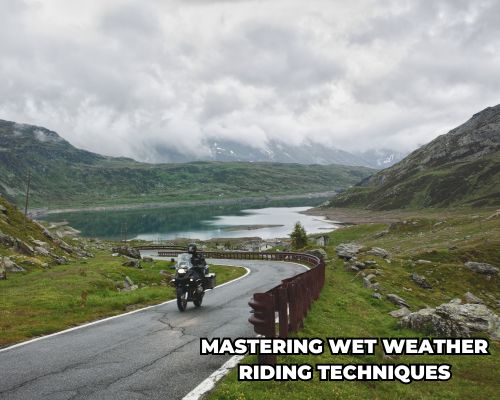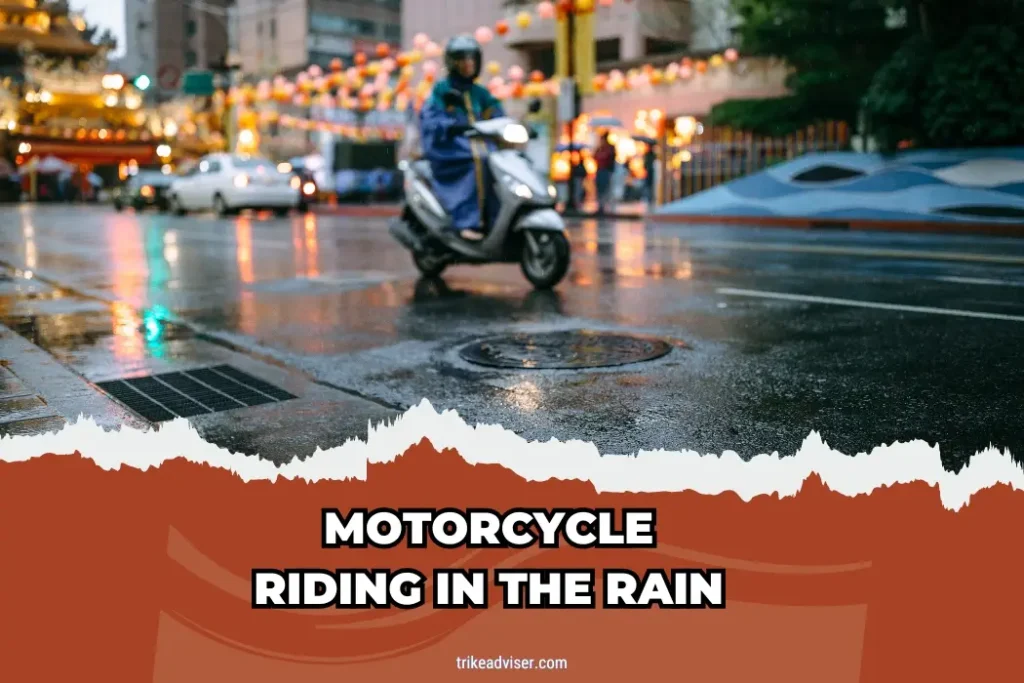Riding in the rain? Most bikers steer clear. Slippery roads, reduced visibility—sounds like a nightmare. But consider this: rain riding is inevitable.
So, why not master it? Think about the last downpour you got caught in. Was it panic stations? Wet roads mocking your tread, visibility down to a blur.
Now, imagine gliding through that storm, confident, secure. No, this isn’t a fantasy. It’s about knowing the ropes, and that’s where we come in.
This isn’t your run-of-the-mill advice. We’re talking real, practical tips every rider needs. From gear checks to handling techniques, we’ve got you covered. So, are you ready to turn those rainy rides from feared to fearless? Let’s dive in.
MOTORCYCLE RIDING IN THE RAIN: 9 Safety Tips For Every Rider
Keep Your Gear Waterproof
Rain pours. You stay dry. Sounds good? Invest in waterproof gear. Jackets, pants, gloves. Don’t forget covers for your boots. Visibility matters. Choose bright or reflective gear. It’s about being seen, not just staying dry.
Tires Matter—Check Them
Tread depth is your friend in the rain. More tread means better water dispersal. Check tire pressure too. Incorrect pressure can lead to a slippery situation. Remember, good tires could mean the difference between a slip and a grip.
Slow Down, Increase Distance
Speed thrills but kills. Especially in the rain. Reaction times increase. So does braking distance. Reduce speed. Increase following distance. Double it from what you usually maintain. Safety first, always.
Brake with Care
Braking in the rain? It’s an art. Use both brakes. But gently. Rear brake first, then front. Avoid sudden movements. Smooth is the way to go. It keeps you in control, keeps you safe.
Avoid Puddles and Painted Lines
Puddles hide potholes. Painted lines become slick. Both are traps for the unwary rider. Steer clear. Choose your path with care. Stay safe, stay upright.
Use Anti-fog Measures
Fogged visors block vision. Not good. Use anti-fog visor inserts. Open vents for airflow. Seeing clearly is non-negotiable. Stay sharp, stay safe.
Lights On
Dim visibility? Lights on. Always. It makes you visible to others. A bright front light and a flashing rear light. Be seen, be safe.
Smooth Sailing with Control
Jerky movements betray you on wet roads. Smooth throttle, smooth steering, smooth shifting. Keep it fluid, keep it controlled. It’s the smooth way to safety.
Know Your Limits
Finally, know when to call it. Riding in the rain tests limits. Yours and your bike’s. If it’s too much, there’s no shame in waiting it out. Safety over pride, every time.
Understanding Road Conditions

Rain transforms roads. What’s usually benign becomes treacherous. Let’s break it down.
How Rain Affects Different Road Surfaces
- Asphalt: Fresh rain lifts oil to the surface, creating slick spots. Beware these rainbows.
- Gravel: Turns into a slippery mush. Wheels dig in deeper, challenging control.
- Other Surfaces: Metal covers, manhole covers, and painted lines turn into ice-like hazards. Tread lightly.
Navigating these conditions requires knowledge and skill. Recognizing danger is the first step to safety.
Identifying Hazardous Road Conditions in Wet Weather
- First 30 Minutes: Most dangerous. Oil and grime surface, making roads slick.
- Puddles: Hidden potholes await. Approach with caution or avoid altogether.
- Flooded Areas: Can sweep you off. If water’s depth or flow is unknown, don’t risk it.
- Mud and Leaves: Nature’s slip-n-slide. Especially treacherous on curves.
Essential Rain Gear for Riders

Rainy rides demand more than just courage. They demand the right gear. Let’s dive in.
Choosing the Right Waterproof Clothing and Accessories
- Jackets and Pants: Look for waterproof yet breathable materials. Sealed seams are a must. Trapped moisture inside is as bad as rain getting in.
- Gloves: Waterproof gloves keep your hands dry and grip secure. Opt for tactile ones to maintain handlebar control.
- Boots: Your feet are closest to the puddles. Waterproof boots with a good grip are non-negotiable.
Fit is crucial. Too tight, and you’re a walking sauna. Too loose, and water sneaks in. Find that perfect middle.
The Importance of Visibility: Reflective and High-Visibility Gear
- Reflective Clothing: In low light, reflective details make you stand out. It’s about catching the eye of drivers.
- High-Visibility Accessories: Neon vests, helmet strips, or bike lights—choose accessories that scream ‘I’m here!’
Mastering Wet Weather Riding Techniques

Riding in the rain isn’t just about endurance. It’s about skill. Fine-tune these techniques to keep the rubber side down.
Advanced Braking Techniques for Slippery Conditions
- Gentle Touch: Sudden brakes are your enemy. Apply them gently, gradually increasing pressure.
- Rear Before Front: Start with the rear brake to reduce the risk of skidding. Then, lightly use the front.
- ABS Advantage: If you have ABS, trust it. It’s designed for moments like these.
Timing and balance are everything. Practice in safe conditions before the skies open.
Maneuvering and Cornering on Wet Roads
- Slow In, Steady Out: Enter turns slower than you normally would. Maintain a steady speed throughout the turn.
- Upright and Smooth: Keep the bike as upright as possible. Lean with your body, not the bike.
- Look Where You Want to Go: Your bike follows your gaze. Look through the turn, not at the ground.
Group Riding in Wet Conditions
Riding in rain is one thing. Doing it in a group? That’s a whole other level of teamwork. Let’s get into it.
Tips for Safely Riding in Groups During Rainy Weather
- Increase Gaps: Normally close formations? Spread out. More space means more reaction time.
- Lead Wisely: The front rider sets the pace. It should be cautious, predictable. No sudden moves.
- Tail Position: The last rider keeps tabs on the group, ensuring no one is left behind.
Safety in numbers, yes, but space is safety’s friend in the rain.
Communication Strategies and Formation Riding in the Rain
- Hand Signals and Lights: Visual cues are king. Ensure everyone knows the signals before heading out.
- Headlights On: All bikes keep headlights on. It enhances visibility, not just for cars but for each other.
- Staggered Formation: This allows each rider a better view of the road ahead and space to maneuver.
As an Amazon Associate, I earn from qualifying purchases, at no additional cost to you. Read Our Affiliate Disclosure.

